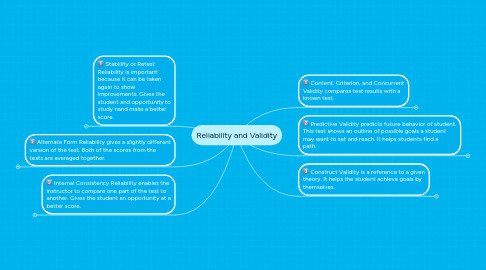Reliability and Validity
por Mona Fisher


1. Content, Criterion, and Concurrent Validity compares test results with a known test.
1.1. Task
1.1.1. Sub task
1.1.2. Sub task
1.1.3. Sub task
1.2. Task
1.2.1. Sub task
1.2.2. Sub task
1.2.3. Sub task
2. Predictive Validity predicts future behavior of student. This test shows an outline of possible goals a student may want to set and reach. It helps students find a path.
2.1. Task
2.1.1. Sub task
2.1.2. Sub task
2.1.3. Sub task
2.2. Task
2.2.1. Sub task
2.2.2. Sub task
2.2.3. Sub task
3. Construct Validity is a reference to a given theory. It helps the student achieve goals by themselves.
3.1. Task
3.1.1. Sub task
3.1.2. Sub task
3.1.3. Sub task
3.2. Task
3.2.1. Sub task
3.2.2. Sub task
3.2.3. Sub task
4. Stablility or Retest Reliability is important because it can be taken again to show improvements. Gives the student and opportunity to study nand make a better score.
4.1. Task
4.1.1. Sub task
4.1.2. Sub task
4.1.3. Sub task
4.2. Task
4.2.1. Sub task
4.2.2. Sub task
4.2.3. Sub task
5. Alternate Form Reliability gives a slightly different version of the test. Both of the scores from the tests are averaged together.
5.1. Task
5.1.1. Sub task
5.1.2. Sub task
5.1.3. Sub task
5.2. Task
5.2.1. Sub task
5.2.2. Sub task
5.2.3. Sub task
6. Internal Consistency Reliability enables the instructor to compare one part of the test to another. Gives the student an opportunity at a better score.
6.1. Task
6.1.1. Sub task
6.1.2. Sub task
6.1.3. Sub task
6.2. Task
6.2.1. Sub task
6.2.2. Sub task
6.2.3. Sub task
